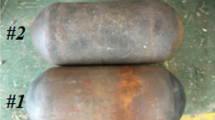Abstract
Barkhausen noise analysis and hysteresis loop (HL) measurements are effective methods for characterizing ferromagnetic materials. This study employs metrology-enabled non-destructive testing methods to measure and evaluate the magnetic properties of two different types of steel, IS 2062 and AISI D2 Tool Steel, and aims to establish a correlation between their Barkhausen parameters and (HL) characteristics by varying the magnetizing frequency and magnetic field intensity. Additionally, permeability and remanence were analyzed for the low, medium, and high ranges of the magnetizing frequency. The AISI D2 tool steel exhibited a weaker response in terms of peak and root-mean-square values compared to the IS-2062 steel, likely due to its smaller grain size. The average permeability and remanence showed an inverse relationship with respect to the low-frequency range, with the magnitude of average permeability being lower in the AISI D2 tool steel due to its higher hardness level. The study of this research also demonstrated the potential of metrology-enabled non-destructive testing techniques for accurately evaluating magnetic properties in steel, which can be valuable for quality control and process optimization in the steel industry.







Similar content being viewed by others
References
N. Broqvist, S. Hogmark, A. Medvedeva and S. Gunnarsson, On wear resistance of tool steel. J. Manuf. Process., 14 (2012) 195–198.
L. Norström and N. Öhrberg, Development of hot-work tool steel for high-temperature applications. Met. Technol., 8 (1981) 22–26.
I. Valls, B. Casas, N. Rodríguez and U. Paar, Benefits from using high thermal conductivity tool steels in the hot forming of steels. Metall. Ital., 102 (2010) 23–28.
I. Mutlu, E. Oktay and S. Ekinci, Characterization of microstructure of H13 tool steel using ultrasonic measurements. Russ. J. Nondestruct. Test., 49 (2013) 112–120.
A.R. de Oliveira, M. Jovičević-Klug, V.F. de Oliveira, J.C. Teixeira and E.G. Del Conte, Barkhausen Noise monitoring of microstructure and surface residual stress in maraging steel manufactured by Powder Bed Fusion and aging. Int. J. Adv. Manuf. Technol., 119 (2022) 1835–1852.
V. Diwakar, A. Sharma, M.Z.K. Yusufzai and M. Vashista, Barkhausen Noise Signal Analysis of IS 2062 Steel and AISI D2 Tool Steel with Different Range of Magnetizing Frequency and Intensity. Russ. J. Nondestruct. Test., 58 (2022) 821–832.
M. Vashista and S. Paul, Correlation between surface integrity of ground medium carbon steel with Barkhausen Noise parameters and magnetic hysteresis loop characteristics. Mater. Des., 30 (2009) 1595–1603.
B. Nahak, A. Srivastava, M.Z. Khan Yusufzai, M. Vashista, Surface Integrity Assessment Upon Electric Discharge Machining of Die Steel Using Non-Destructive Magnetic Barkhausen Noise Technique, Trans. Indian Inst. Met., 73 (2020) 967–974.
O. Saquet, J. Chicois and A. Vincent, Barkhausen noise from plain carbon steels: Analysis of the influence of microstructure. Mater. Sci. Eng. A., 269 (1999) 73–82.
M. Kaplan, C.H. Gür and M. Erdogan, Characterization of dual-phase steels using Magnetic Barkhausen noise technique. J. Nondestruct. Eval., 26 (2007) 79–87.
J.N. Mohapatra, S. Mohanty, S.K. Dabbiru and I. Tripathy, Correlation of Magnetic Properties with Mechanical Properties of a High Tensile Grade Steel in Various Heat Treated Conditions. Trans. Indian Inst. Met., 71 (2018) 2361–2374.
A. Chaudhari, A. Sharma, A.S. Awale, M.Z.K. Yusufzai, M. Vashista, Effect of ultrasonic vibration assisted dry grinding on hysteresis loop characteristics of AISI D2 tool steel, Sadhana - Acad. Proc. Eng. Sci., 46 (2021).
J.A. Pérez-Benitez, L.R. Padovese, J. Capó-Sánchez and J. Anglada-Rivera, Investigation of the magnetic Barkhausen noise using elementary signals parameters in 1000 commercial steel. J. Magn. Magn. Mater., 263 (2003) 72–77.
K.V. Rajkumar, S. Vaidyanathan, A. Kumar, T. Jayakumar, B. Raj and K.K. Ray, Characterization of aging-induced microstructural changes in M250 maraging steel using magnetic parameters. J. Magn. Magn. Mater., 312 (2007) 359–365.
A. Martínez-de-Guerenu, K. Gurruchaga and F. Arizti, Nondestructive characterization of recovery and recrystallization in cold rolled low carbon steel by magnetic hysteresis loops. J. Magn. Magn. Mater., 316 (2007) 842–845.
D. O’Sullivan, M. Cotterell and I. Meszaros, The characterisation of work-hardened austenitic stainless steel by NDT micro-magnetic techniques. NDT E Int., 37 (2004) 265–269.
S. Vaidyanathan, V. Moorthy, T. Jayakumar and B. Raj, Evaluation of induction hardened case depth through microstructural characterisation using magnetic Barkhausen emission technique. Mater. Sci. Technol., 16 (2000) 202–208.
P. Fagan, B. Ducharne, L. Daniel, A. Skarlatos, M. Domenjoud, C. Reboud, Effect of stress on the magnetic Barkhausen noise energy cycles: A route for stress evaluation in ferromagnetic materials, Mater. Sci. Eng. B Solid-State Mater. Adv. Technol., 278 (2022) 1–34.
Z. Qian, H. Zeng, H. Liu, Y. Ge, H. Cheng, H. Huang, Effect of Hard Particles on Magnetic Barkhausen Noise in Metal Matrix Composite Coatings: Modeling and Application in Hardness Evaluation, IEEE Trans. Magn., 58 (2022).
A. Staub, M. Scherer, P. Zehnder, A.B. Spierings, K. Wegener, Residual Stresses Measurements in Laser Powder Bed Fusion Using Barkhausen Noise Analysis, Materials (Basel)., 15 (2022).
A. Sorsa, M. Ruusunen, S. Santa-aho and M. Vippola, Sub-Surface Analysis of Grinding Burns with Barkhausen Noise Measurements. Materials (Basel), 16 (2023) 1–15.
A. Sharma, A. Chaudhari, A.S. Awale, M.Z.K. Yusufzai and M. Vashista, Effect of Grinding Environments on Magnetic Response of AISI D2 Tool Steel. Russ. J. Nondestruct. Test., 57 (2021) 212–221.
Author information
Authors and Affiliations
Corresponding author
Ethics declarations
Conflict of interest
The authors declare that they have no financial or personal interests that could have appeared to influence the work reported in this manuscript.
Additional information
Publisher's Note
Springer Nature remains neutral with regard to jurisdictional claims in published maps and institutional affiliations.
Rights and permissions
Springer Nature or its licensor (e.g. a society or other partner) holds exclusive rights to this article under a publishing agreement with the author(s) or other rightsholder(s); author self-archiving of the accepted manuscript version of this article is solely governed by the terms of such publishing agreement and applicable law.
About this article
Cite this article
Diwakar, V., Sharma, A., Yusufzai, M.Z.K. et al. Measurement and Analysis of Magnetic Properties in IS 2062 Steel and AISI D2 Tool Steel Via Non-destructive Testing. MAPAN 38, 489–498 (2023). https://doi.org/10.1007/s12647-023-00637-x
Received:
Accepted:
Published:
Issue Date:
DOI: https://doi.org/10.1007/s12647-023-00637-x




